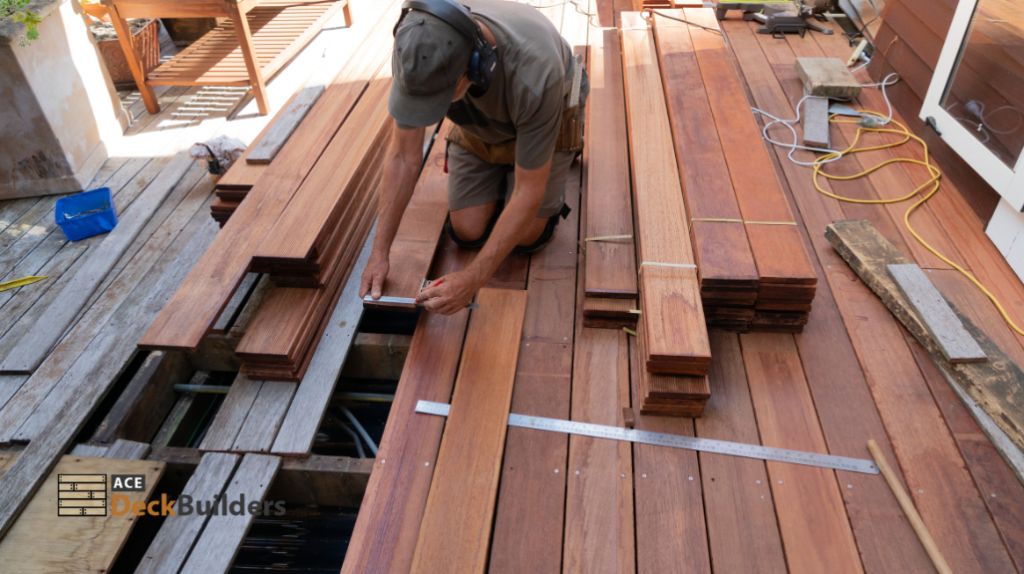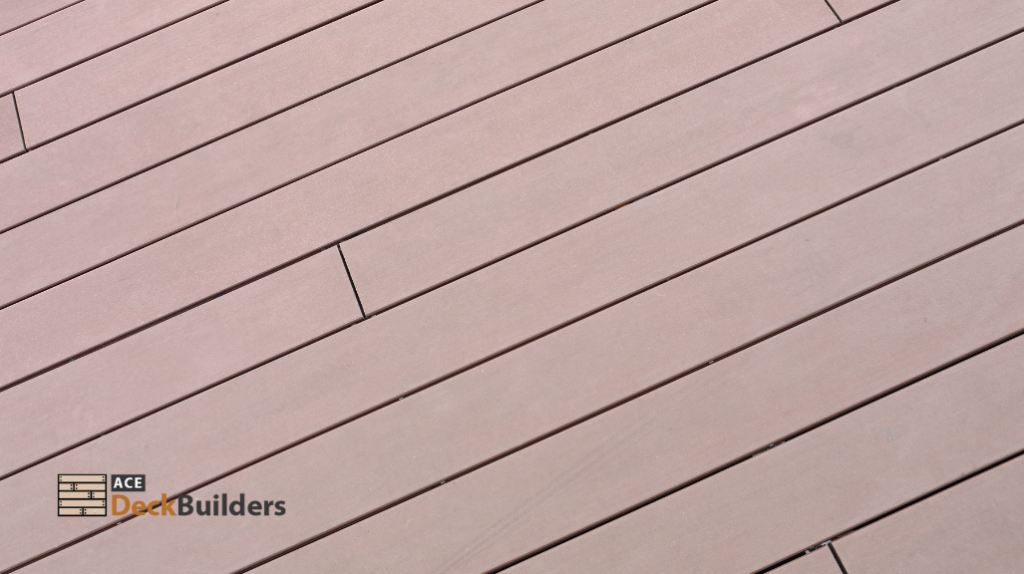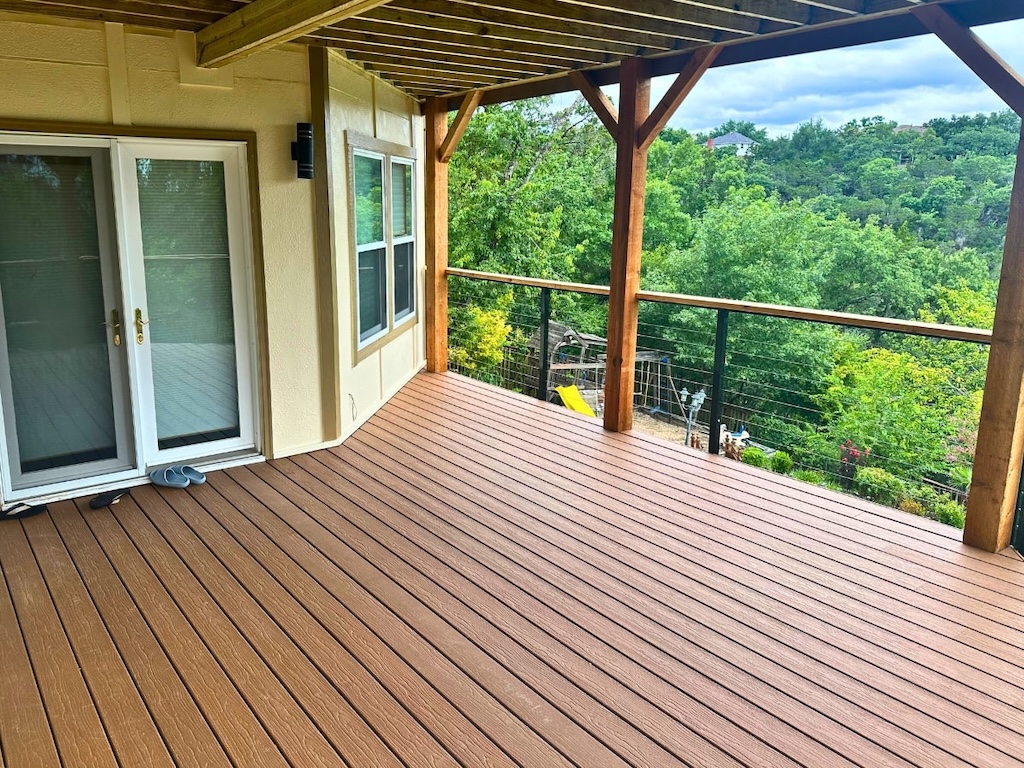TL;DR
For Austin replacements, choose materials by how you’ll use the deck, sun exposure, and maintenance tolerance. Cedar is cooler underfoot and cheaper up front but needs regular finishing, whereas composite decking offers lower upkeep . Composite offers stable color and lower upkeep, though darker tones run hotter in midday sun. PVC leads for moisture resistance and color stability with the highest upfront price. Whatever you pick, performance hinges on framing, ventilation, fasteners, and inspection-clean details. For a quick sense of the craftsmanship standard to aim for, browse the portfolio and process on Ace Deck Builders.
Table of Contents
ToggleWhy Material Choice Matters More on a Replacement

Replacement projects are the perfect reset: you already know what didn’t work—hot boards, faded color, flexy rails, or constant maintenance. You also know how you actually use the space. Material choice, especially when considering the best decking materials, becomes less about brochure promises and more about lived experience:
- Do you grill at 6 pm with west sun blasting the deck?
- Do kids and pets run barefoot at midday?
- Do you want a once-a-year rinse—or are you OK with stain/seal cycles?
- Will you sell within a few years and prioritize appearance/warranty for resale?
Answer those honestly, then align various deck material options to the outcomes that matter most.
Decision Factors (Use This First)
Use these three filters before you even look at color swatches:
- Sun & Shade Map
Track where the deck bakes from noon–6 pm in July. Full-sun decks push you toward lighter composites/PVC or cedar with serious shade planning. Partial-shade expands options. - Maintenance Appetite
- Low maintenance: composite or PVC
- OK with upkeep: cedar (stain/seal every 12–24 months depending on exposure)
- Comfort & Texture
If barefoot comfort rules, lighter tones and embossed textures help. Ask for sample boards and heat-test them in your yard for a week.
Everything after this—budget, color, railing style—flows from the big three.
Cedar & Other Softwoods: Pros, Cons, Best Fits
Pros
- Naturally cooler underfoot than many dark composites.
- Warm, authentic grain that weathers attractively when maintained.
- Lower upfront cost; easy to work, cut, and shape on site.
Cons
- Requires regular maintenance: clean + stain/seal on a 12–24 month cadence depending on exposure.
- Color shift and checking if neglected.
- Shorter warranty coverage vs. engineered boards; performance relies heavily on finish discipline.
Best fits
- Shaded or morning-sun decks where barefoot comfort is the top priority.
- Homeowners who enjoy (or will reliably schedule) finish maintenance.
- Projects where budget now matters more than year-over-year maintenance costs.
Pro tip: If you love cedar but hate frequent staining, plan a shade strategy (pergola, strategic planting, light rail caps) and commit to a maintenance calendar right in the closeout packet.
Composite Boards: Pros, Cons, Best Fits

Pros
- Low routine maintenance (no cyclical staining), stable color, wide design choices.
- Many lines match with fascia, trim, and hidden fasteners for a polished look.
- Strong resale optics when paired with clean rails and stairs.
Cons
- Some series run hot under full sun, especially in darker colors.
- Requires proper ventilation and gapping; ignore those and you can invite movement or warranty issues.
- Mid-to-high upfront cost.
Best fits
- High-use decks where owners want a rinse-and-go routine.
- West-facing decks when you can choose lighter tones and/or add shade.
- Households selling in the next 3–5 years who want consistent appearance with minimal upkeep.
PVC Boards: Pros, Cons, Best Fits
Pros
- Top-tier moisture resistance and excellent color stability.
- Often lighter in weight and dimensionally stable when installed per spec.
- Pairs well with high-design rail systems for a luxury finish.
Cons
- Highest upfront cost of the three categories.
- Requires correct fastening, edge support, and ventilation to shine.
- Some lines can still feel warm under intense sun—tone choice matters.
Best fits
- Poolside or heavily irrigated landscapes, where moisture management is critical.
- Homeowners prioritizing long-term appearance with the least maintenance.
- Elevated, showcase decks where you want premium finishes end-to-end.
Surface Temperature & Comfort (Austin Heat Reality)
Heat is Austin’s tie-breaker. A few truths about deck replacement materials :
- Color > material for temperature: lighter hues are almost always more comfortable underfoot than dark ones, regardless of board technology.
- Texture helps: embossed, matte finishes feel better than slick, dense surfaces at noon.
- Shade wins: a small pergola section, sail, or strategically placed umbrella changes deck usability more than nearly any spec choice.
Home test: Put three sample boards where the sun hits hardest and check them at noon and 5 pm. Have everyone in the house do the barefoot test—it’s the most honest data you’ll get.
Maintenance & Finish Cycles (10-Year View)
Think in decades, not seasons:
- Cedar: plan for clean + stain/seal on a 12–24 month cycle. The cost is modest each time, but it’s recurring. Miss cycles and you’ll spend more catching up.
- Composite: rinse, occasional soap scrub; no staining cycles.
- PVC: similar to composite, often even more stain-resistant.
If you know you’ll skip maintenance, choose materials that forgive you, like wood composite or PVC in lighter tones. composite or PVC in lighter tones.
Framing, Fasteners & Ventilation (Where Performance Is Won)
Material durability is only as good as what’s underneath and how it’s fastened:
- Spans & Joist Spacing: Composite and PVC often want tighter spacing than wood. Follow the board manufacturer’s span table.
- Ledger & Flashing: Non-negotiable. Proper flashing protects the home envelope and keeps replacement decks from repeating old failures.
- Ventilation: Low decks need air. Without it, any board gets warmer and framing ages faster. Leave specified gaps and don’t block airflow with solid skirting.
- Fasteners: Use the system specified—hidden fasteners or plug systems for many composites/PVC; quality screws for wood. Stainless near pools is smart.
For a deeper dive into how a pro handles permitting, inspections, and those ledger/fastener details during a rebuild, skim a process overview for deck replacement in Austin mid-research so you can benchmark scheduling and craftsmanship expectations.
Railings, Stairs & Skirting: The Hidden Cost Drivers
Homeowners often fixate on deck boards, but rails and stairs change budgets and user experience:
- Rails: Cable and glass look amazing—and cost more in hardware and labor. Wood or composite pickets are value wins.
- Stairs: Each run adds layout time, stringer cuts, blocking, and code checks. Consolidating to one well-placed run often saves money.
- Skirting & Fascia: Full wraps and layered fascia elevate the look but add material and labor. Consider partial wraps on public-facing sides.
If you’re trying to stretch into a higher-end board, value-engineer the rail first—clean, simple rail with a premium deck surface usually reads “high-end” from 10 feet away.
Aesthetics & Design: Color, Texture, and Pattern Tricks
- Two-tone looks (field + picture frame) sharpen edges and hide cut lines.
- Diagonal vs. orthogonal: Diagonals can add stiffness and visual interest but may require tighter joist spacing.
- Break up long runs with divider boards to control gapping and reduce waste.
- Matte finishes hide footprints and dust better than high-gloss embossing.
Bring your siding, roof, and masonry into the conversation. Light, neutral boards with darker railings photograph beautifully and stay current longer.
Budgeting the Upgrade (What Moves the Needle)

- Choose in-stock boards & rail kits to avoid lead-time price creep.
- Standardize dimensions to material lengths (12/16/20 ft) to cut waste.
- Pick lighter tones to reduce the need for pricey shade structures.
- Simplify railing infill (pickets > cable > glass) to reallocate budget to better boards.
- Phase accessories (benches, screens) after the main build if needed.
If you’re leaning toward engineered boards and want a feel for install specifics and finish options, a focused look at composite deck installation will help you understand fastening systems, fascia ventilation, and how to keep warranties intact.
Want a broader primer that catalogs the board categories and how they differ? This overview of the best types of deck materials is handy for side-by-side comparisons before you pick final colors.
Neighborhood & HOA Considerations
Many Austin HOAs want color samples and drawings before you build. Submit exact series names (not just “gray composite”), railing styles, and a simple elevation sketch. This prevents re-submittals that push your schedule.
Sample Specs for Common Scenarios
1) South-/West-Facing, Full Sun, High Foot Traffic
- Board: Light-tone composite or PVC with matte embossing
- Rail: Composite pickets (value) or cable (premium look, hotter budget)
- Details: Hidden fasteners, picture frame border, divider boards to manage runs
- Shade: Small pergola pad or sail over the most-used zone
2) Shaded Morning Deck, Budget-Aware
- Board: Cedar with stain/seal plan (calendar reminders)
- Rail: Wood pickets, stain to match or contrast
- Details: Stainless screws on stair treads; ventilation gap at skirting; simple fascia wrap
3) Poolside or Heavy Irrigation Zone
- Board: PVC with specified gapping and edge support
- Rail: Composite or powder-coated aluminum pickets
- Details: Stainless hardware; anti-slip attention at stairs; light-tone surfaces for comfort
FAQs
Darker tones can. Choose lighter colors as the best choice , consider matte textures, and plan targeted shade. Always heat-test sample boards at your home before you commit.
Only if the frame meets current span/spacing tables, has a properly flashed ledger, and passes a thorough inspection. Many older frames need upgrades during replacement.
Usually not. Cedar is cheaper upfront than wooden decks, but maintenance cycles add cost. Composite or PVC often wins over 10 years—especially if maintenance slips.
Engineered boards carry material warranties, but installation requirements (gapping, ventilation, fasteners) must be met, especially when using natural wood . Keep those details in your contract and closeout packet.
Once permits and materials are set, many Austin replacements complete in 2–4 weeks on site, with schedule depending on rail/stair complexity and inspections.
Get a Materials Recommendation You Won’t Regret
Want a side-by-side comparison for your exact sun exposure, rail length, and budget—plus a schedule tied to inspection hold points? Start with a free deck estimate in Austin and we’ll bring samples, map heat/UV trade-offs, and give you a clear, itemized plan from tear-off to toast-worthy finish.
